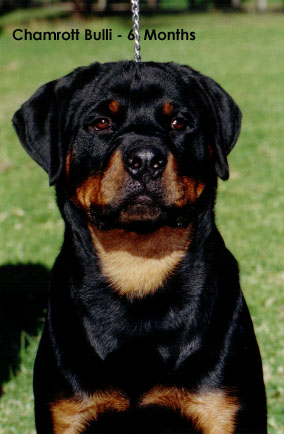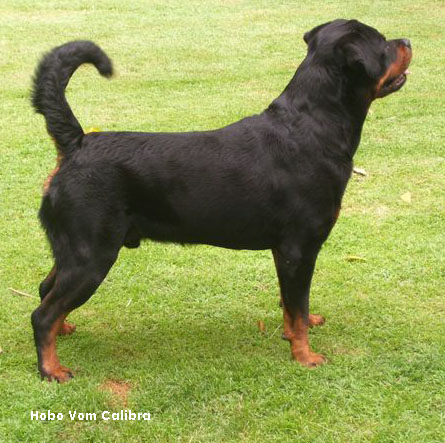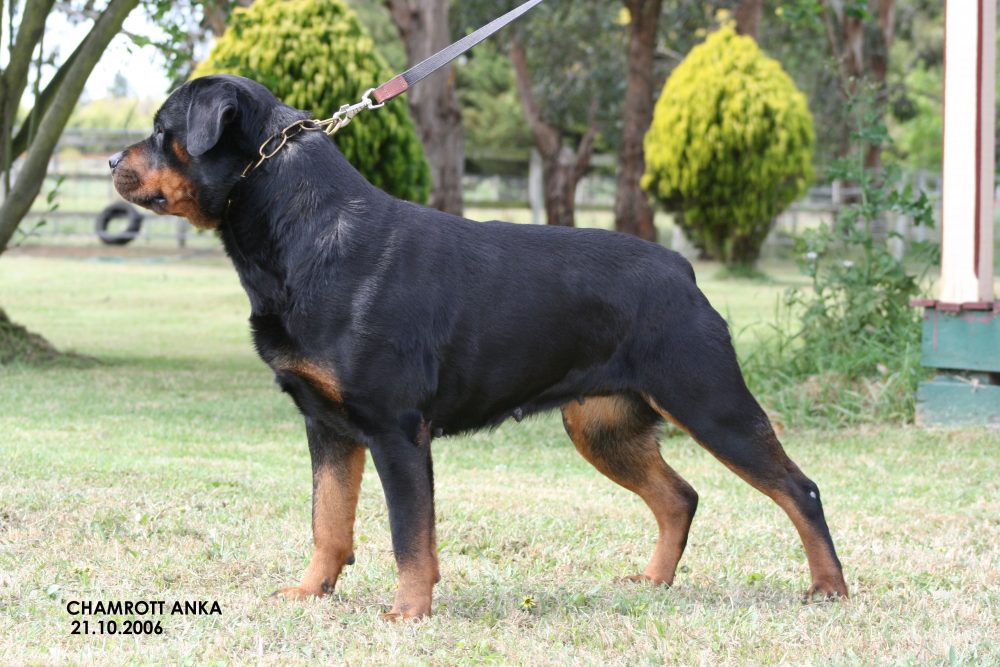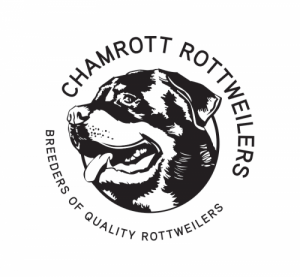
History Of The Rottweiler
The Rottweiler is considered to be one of the oldest dog breeds. Its origin goes back to Roman times. These dogs were kept as herder or driving dogs. They marched over the Alps with the Roman legions, protecting the humans and driving their cattle. In the region of Rottweil, these dogs met and mixed with the native dogs in a natural crossing.
The main task of the Rottweiler now became the driving and guarding of the herds of cattle and the defence of their masters and their property. This breed acquired its name from the old free city of Rottweil and was known as the „Rottweil butcher’s dog“.
The butchers bred this type of dog purely for performance and usefulness. In due course, a first rate watch and driving dog evolved which could also be used as a draught dog. When, at the beginning of the twentieth century, various breeds were needed for police service, the Rottweiler was amongst those tested.
It soon became evident that the breed was highly suitable for the tasks set by police service and therefore they were officially recognized as police dogs in 1910.
Rottweiler breeders aim at a dog of abundant strength, black coated with clearly defined rich tan markings, whose powerful appearance does not lack nobility and which is exceptionally well suited to being a companion, service and working dog.
General Appearance
The Rottweiler is a medium to large size, stalwart dog, neither heavy nor light and neither leggy nor weedy. His correctly proportioned, compact and powerful build leads to the conclusion of great strength, agility and endurance.
IMPORTANT PROPORTIONS
The length of the body, measured from the sternum (breast-bone) to the ischiatic uberosity, should not exceed the height at the withers by, at most, 15 %.
BEHAVIOUR / TEMPERAMENT
Good natured, placid in basic disposition and fond of children, very devoted, obedient, biddable
and eager to work. His appearance is natural and rustic, his behaviour self assured, steady and fearless. He reacts to his surroundings with great alertness.

HEAD:
CRANIAL REGION:
Skull: Of medium length, broad between the ears. Forehead line moderately arched as seen from the side. Occipital bone well developed without being conspicuous.
Stop: Well defined.
FACIAL REGION
Nose: Nose well developed, more broad than round with relatively large nostrils, always black.
Muzzle: The foreface should appear neither elongated nor shortened in relation to the cranial region. Straight nasal bridge, broad at base, moderately tapered.
Lips: Black, close fitting, corner of the mouth not visible, gum as dark as possible.
Jaws / Teeth: Upper and lower jaw strong and broad. Strong complete dentition (42 teeth) with scissor bite, the upper incisors closely overlapping the lower incisors.
Cheeks: Zygomatic arches pronounced.
Eyes: Of medium size, almond shaped, dark brown in colour. Eyelids close fitting.
Ears: Medium-sized, pendant, triangular, wide apart, set on high. With the ears laid forward close to the head the skull appears to be broadened.
NECK Strong, of fair length, well muscled, slightly arched, free from throatiness, without dewlap.
BODY
Back: Straight, strong, firm.
Loins: Short, strong and deep.
Croup: Broad, of medium length, slightly rounded. Neither flat nor falling away.
Chest: Roomy, broad and deep (approximately 50 % of the shoulder height) with well developed forechest and well sprung ribs.
Belly: Flanks not tucked up.
TAIL: In natural condition, level in extension of the upper line; at ease may be hanging
LIMBS
FOREQUARTERS: Seen from the front, the front legs are straight and not placed too closely to each other. The forearm, seen from the side, stands straight. The slope of the shoulder blade is about 45 degrees to the horizontal.
Shoulders: Well laid back.
Upper arm: Close fitting to the body.
Forearm: Strongly developed and muscular.
Pasterns: Slightly springy, strong, not steep.
Front feet: Round, tight and well arched; pads hard; nails short, black and strong.
HINDQUARTERS: Seen from behind, legs straight and not too close together. When standing free, obtuse angles are formed between the dog’s upper thigh and the hip bone, the upper thigh and the lower thigh and the metatarsal.
Upper thigh: Moderately long, broad and strongly muscled.
Lower thigh: Long, strongly and broadly muscled at top, sinewy.
Hocks: Sturdy well angulated hocks; not steep.
Hindfeet: Slightly longer than the front feet. Toes strong, arched, as tight as front feet.
GAIT The Rottweiler is a trotting dog. In movement the back remains firm and relatively stable. Movement harmonious, steady, full of energy and unrestricted, with good stride.
SKIN
Skin on the head: Overall tight fitting. When the dog is alert, the forehead may be slightly
wrinkled.
COAT
HAIR: The coat consists of a top coat and an undercoat. The top coat is of medium length, coarse, dense and flat. The undercoat must not show through the top coat. The hair is a little longer on the hindlegs.
COLOUR: Black with clearly defined markings of a rich tan on the cheeks, muzzle, throat, chest and legs, as well as over both eyes and under the base of the tail.
SIZE AND WEIGHT
Height at withers: For males is 61 - 68 cm.
61 - 62 cm is small 63 - 64 cm is medium height
65 - 66 cm is large - correct height 67 - 68 cm is very large
Weight: approximately 50 kg
Height at withers: For bitches is 56 - 63 cm.
56 - 57 cm is small 58 - 59 cm is medium height
60 - 61 cm is large - correct height 62 - 63 cm is very large
Weight: approximately 42 kg

Stages Of Development
The size of a Rottweiler coupled with his strength of character will cause problems right from the time you take your puppy home if you do not establish yourself as the pack leader in your household. The dog will be quite happy with what ever position he is allotted. For household harmony that position should be at the bottom of the human pack. Then the dog respects you and all the family. Current problems overseas are mainly caused by lack of understanding of the above concept. The Rottweiler is a wonderful companion / guard, providing he is in the hands of a responsible caring owner who has taken the trouble to investigate the Character of the Breed and to learn about the drives and instincts that all dogs are born with, ie., inherited drives and behaviour. This is set and cannot be changed by man, only modified for man's use.
THE AIM OF SOCIALISATION
To teach the dog those things he would not learn unless instructed, ie., not to wet in the house and all other social activities which are not inherent in the dog but necessary for him to fit into our society.
To inhibit and channel those natural activities that are instinctive to the dog. Again so he can become a useful member of society and contented to use his instinct in a positive way, ie., to fetch articles on command and bring them to his owner, not to drag the washing off the line and bury them.
Socialisation is continuous throughout the life of the dog, but the first 16 weeks is vital. Miss taking the time during this period to introduce your pup to various situations in a non stressful way and you will never have the dog you could have had.
CRITICAL PERIOD
Birth to 7 weeks. Puppies learn to accept discipline from their Dam and to interact with their litter mates. They learn to be functional animals within the pack. To give correct signals and responses to other dogs.
SOCIALISATION PERIOD
7 to 12 weeks. At this age the dog is capable of learning anything as its brain has the capacity of an adult dog. This is a valuable period and should not be wasted. Spend as much time as you can introducing your dog to all the things he will encounter during his lifetime. Introduce him to other animals that are non-threatening. Things that are learned at this time are retained. Concentration is limited so teaching should be short and happy.
FEAR PERIOD
This period occurs sometime between 8 and 16 weeks. Things that a pup happily accepted before, may or a short time appear threatening and produce fear in the puppy. Recognise that this is just a stage and will pass. Do not force the puppy to confront the thing he fears. Just be calm and non fearful yourself, treat the thing that puppy fears with disdain and he will take his cue from you. Do not over protect or display too much concern.
FITTING INTO POSITION IN YOUR FAMILY GROUP 12 to 16 weeks
This is the testing period when the puppy decides whether he is number two in your family or comes after all the other family members. The puppy will test you and the other family members to find his place. Things like biting at the lead or his owner should be discouraged and firmly corrected. All family members should be able to direct the puppy and expect him to comply. Puppy should now be sleeping all night quietly in his own bed and be walking well on a lead. He should know his name by now and be able to stay quietly by himself without howling or barking and should not destroy things.
At this stage you might believe that your puppy has all of a sudden become deaf. They attempt to ignore you, make sure that you are in a position to make the puppy listen. This period only lasts a short time but is always sometime around the 4th to 6th month.
SECOND FEAR PERIOD 6 to 14 months
Your puppy may suddenly become terror stricken about something he has seen many times before. This is illogical behaviour and like a child having a nightmare. Just be calm and reassuring and avoid confrontation while the puppy is unable to cope. This will soon pass if you don't make an issue of the fear. Work on having the puppy learn to rely on you for guidance and support, while learning to be independent. Rottweilers are naturally aware of changes in their surrounding and may act as if they are wary of new things and people. Do not reassure the pup in these circumstances. Just act as if the object is of no consequence to you and the pup will take the cue from you. If you pat and cosset the puppy when it acts afraid the message the dog will get is that it is okay to act in this manner. Far from it, we want our pups to grow into self confident adults.
ADOLESCENCE 12 to 24 months
Your puppy begins to assert himself and to regard all other dogs as potential rivals. This behaviour is not cute and is not socially acceptable. Do not applaud or condone it. Concentrate on reinforcing your earlier training and demand respect and attention from your dog. Be firm, fair and consistent with your discipline. Distract the dog and avoid confrontations with other dogs which will only reinforce the behaviour. This behaviour will settle if not reinforced.
Average Lifespan When considering a dog, please realise that you are taking it on for its lifetime. Rottweilers live up to 12 years of age.
Breed Personality/Characteristics/Temperament The Rottweiler is exceptionally well suited to being a companion, security and working dog. It is good natured, placid, very devoted, obedient and eager to work. It is self assured, steady and fearless. A Rottweiler must learn, from the start, its position in the family (i.e. at the bottom of the human pack). The Rottweiler is usually tolerant of children, but parents need to make sure that any child is taught to treat the dog fairly and should be actively involved in the dog’s education process.
Care Requirements As with all working breeds, the Rottweiler needs firm guidance and training. It is of vital importance that early socialisation be carried out. This means exposure to all the normal everyday events for a puppy, in a non-stressful atmosphere. This is essential if the dog is to be expected to fit the right action to the right situation when mature. The importance of this early grounding, which must be followed up with regular training, cannot be over stressed. The dog must also learn to respect you and know its place in your family. Most problems with Rottweilers arise when the dog is unsure who is in charge, or if conflicting messages come from family members. A Rottweiler requires daily exercise and will not exercise itself adequately alone. It is a companion dog and will wait for you to take it out for exercise. Adult dogs need daily exercise of both brain and body, and daily walking with some obedience training is the best solution. A puppy needs to be able to free run on non-slip surfaces as well as regular controlled walking on leash. Rottweilers are fast-growing dogs, and, as such, are prone to all the problems that such animals exhibit, i.e. hip dysplasia, osteochondritis, etc. The breed clubs have introduced control schemes for these problems. Please discuss health issues with breeders before selecting a puppy.
Ideal Owner/s The ideal owner is a fit, active person who is well versed in dog behaviour or willing to learn. This should be a responsible person who realises that this breed must be well socialised and trained from a small puppy - someone who is willing to share their life and home with a Rottweiler and put in quality time with the dog.
